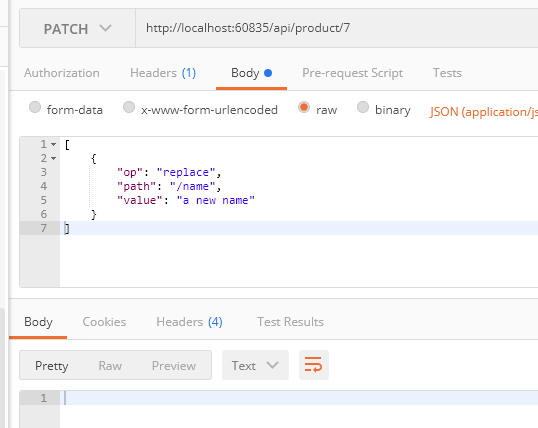第1部分:https://www.yuque.com/net.core/framework/hlvsrm
第2部分:https://www.yuque.com/net.core/framework/hxwrrq
第3部分:https://www.yuque.com/net.core/framework/kitvxp
第4部分:http://www.cnblogs.com/cgzl/p/7661805.html
Github源码地址:
这是第一大部分的最后一小部分。要完成CRUD的操作。
Repository Pattern
我们可以直接在Controller访问DbContext,但是可能会有一些问题:
1.相关的一些代码到处重复,有可能在程序中很多地方我都会更新Product,那样的话我可能就会在多个Action里面写同样的代码,而比较好的做法是只在一个地方写更新Product的代码。
2.到处写重复代码还会导致另外一个问题,那就是容易出错。
3.还有就是难以测试,如果想对Controller的Action进行单元测试,但是这些Action还包含着持久化相关的逻辑,这就很难的精确的找出到底是逻辑出错还是持久化部分出错了。
所以如果能有一种方法可以mock持久化相关的代码,然后再测试,就会知道错误不是发生在持久化部分了,这就可以用Repository Pattern了。
Repository Pattern是一种抽象,它减少了复杂性,目标是使代码对repository的实现更安全,并且与持久化要无关。
其中持久化无关这点我要明确一下,有时候是指可以随意切换持久化的技术,但这实际上并不是repository
pattern的目的,其真正的目的是可以为repository挑选一个最好的持久化技术。例如:**创建一个Product最好的方式可能是使用entity
framework,而查询product最好的方式可能是使用dapper,也有可能会调用外部服务**,而对调用repository的消费者来说,它不关心这些具体的实现细节。
首先再建立一个Material entity,然后和Product做成多对一的关系:
namespace CoreBackend.Api.Entities{public class Material{public int Id { get; set; }public int ProductId { get; set; }public string Name { get; set; }public Product Product { get; set; }}public class MaterialConfiguration : IEntityTypeConfiguration<Material> //configure entity material{public void Configure(EntityTypeBuilder<Material> builder){builder.HasKey(x => x.Id); //set main keybuilder.Property(x => x.Name).IsRequired().HasMaxLength(50);builder.HasOne(x => x.Product).WithMany(x => x.Materials).HasForeignKey(x => x.ProductId).OnDelete(DeleteBehavior.Cascade);}}}
修改Product.cs:
namespace CoreBackend.Api.Entities{public class Product{public int Id { get; set; }public string Name { get; set; }public float Price { get; set; }public string Description { get; set; }public ICollection<Material> Materials { get; set; }}public class ProductConfiguration : IEntityTypeConfiguration<Product> //confiure entity product{public void Configure(EntityTypeBuilder<Product> builder){builder.HasKey(x => x.Id); //set main keybuilder.Property(x => x.Name).IsRequired().HasMaxLength(50);builder.Property(x => x.Price).HasColumnType("decimal(8,2)");builder.Property(x => x.Description).HasMaxLength(200);}}}
然后别忘了在Context里面注册Material的Configuration并添加DbSet属性:
namespace CoreBackend.Api.Entities{public class MyContext : DbContext{public MyContext(DbContextOptions<MyContext> options): base(options){Database.Migrate();}public DbSet<Product> Products { get; set; }public DbSet<Material> Materials { get; set; }//即将在entities中的配置运行到context,并添加Dbset属性protected override void OnModelCreating(ModelBuilder modelBuilder){modelBuilder.ApplyConfiguration(new ProductConfiguration());modelBuilder.ApplyConfiguration(new MaterialConfiguration());}}}
然后添加一个迁移 Add-Migration AddMaterial:
然后数据库直接进行迁移操作了,无需再做update-database。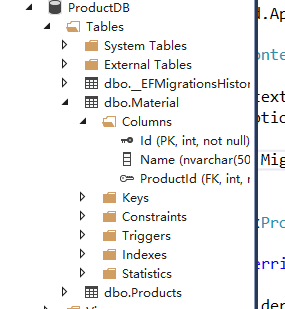
建立一个Repositories文件夹,添加一个IProductRepository:
namespace CoreBackend.Api.Repositories{public interface IProductRepository{IEnumerable<Product> GetProducts();Product GetProduct(int productId, bool includeMaterials);IEnumerable<Material> GetMaterialsForProduct(int productId);Material GetMaterialForProduct(int productId, int materialId);}}
这个是ProductRepository将要实现的接口,里面定义了一些必要的方法:查询Products,查询单个Product,查询Product的Materials和查询Product下的一个Material。
其中类似GetProducts()这样的方法返回类型还是有争议的,IQueryable
如果返回的是IQueryable,那么调用repository的地方还可以继续构建IQueryable,例如在真正的查询执行之前附加一个OrderBy或者Where方法。但是这样做的话,也意味着你把持久化相关的代码给泄露出去了,这看起来是违反了repository
pattern的目的。
如果是IEnumerable,为了返回各种各样情况的查询结果,需要编写几十个上百个查询方法,那也是相当繁琐的,几乎是不可能的。
目前看来,两种返回方式都有人在用,所以根据情况定吧。我们的程序需求比较简单,所以使用IEnumerable。
然后建立具体的实现类 ProductRepository:
//实现接口IRepositorynamespace CoreBackend.Api.Repositories{public class ProductRepository : IProductRepository{private readonly MyContext _myContext;public ProductRepository(MyContext myContext){_myContext = myContext;}//获取所有的productpublic IEnumerable<Product> GetProducts(){return _myContext.Products.OrderBy(x => x.Name).ToList();}//获取单个product的所有信息,如果有material则返回,相反则不返回public Product GetProduct(int productId, bool includeMaterials){if (includeMaterials){return _myContext.Products.Include(x => x.Materials).FirstOrDefault(x => x.Id == productId);}return _myContext.Products.Find(productId);}//根据product查询所有的materialspublic IEnumerable<Material> GetMaterialsForProduct(int productId){return _myContext.Materials.Where(x => x.ProductId == productId).ToList();}//根据productId,materialId精确查询public Material GetMaterialForProduct(int productId, int materialId){return _myContext.Materials.FirstOrDefault(x => x.ProductId == productId && x.Id == materialId);}}}
这里面要包含吃就会的逻辑,所以我们需要MyContext(也有可能需要其他的Service)那就在Constructor里面注入一个。重要的是调用的程序不关心这些细节。
这里也是编写额外的持久化逻辑的地方,比如说查询之后做个排序之类的。
(具体的Entity Framework Core的方法请查阅EF Core官方文档:https://docs.microsoft.com/en-us/ef/core/)
GetProducts,查询所有的产品并按照名称排序并返回查询结果。这里注意一定要加上ToList(),它保证了对数据库的查询就在此时此刻发生。
GetProduct,查询单个产品,判断一下是否需要把产品下面的原料都一起查询出来,如果需要的话就使用Include这个extension method。查询条件可以放在FirstOrDefault()方法里面。
GetMaterialsForProduct,查询某个产品下所有的原料。
GetMaterialForProduct,查询某个产品下的某种原料。
建立好Repository之后,需要在Startup里面进行注册:
//将Repository注册到configureServicespublic void ConfigureServices(IServiceCollection services){services.AddMvc();#if DEBUGservices.AddTransient<IMailService, LocalMailService>();#elseservices.AddTransient<IMailService, CloudMailService>();#endifvar connectionString = Configuration["connectionStrings:productionInfoDbConnectionString"];services.AddDbContext<MyContext>(o => o.UseSqlServer(connectionString));services.AddScoped<IProductRepository, ProductRepository>(); //注册IProductRepository}
针对Repository,最好的生命周期是Scoped(每个请求生成一个实例)。<>里面前边是它的合约接口,后边是具体实现。
使用Repository
先为ProductDto添加一个属性(MaterialCount):
namespace CoreBackend.Api.Dtos{public class ProductDto{public ProductDto(){Materials = new List<MaterialDto>();}public int Id { get; set; }public string Name { get; set; }public float Price { get; set; }public string Description { get; set; }public ICollection<MaterialDto> Materials { get; set; }public int MaterialCount => Materials.Count;}}
就是返回该产品所用的原料个数。
再建立一个ProductWithoutMaterialDto->**没有原料**:
namespace CoreBackend.Api.Dtos{public class ProductWithoutMaterialDto{public int Id { get; set; }public string Name { get; set; }public float Price { get; set; }public string Description { get; set; }}}
这个Dto不带原料相关的导航属性。
然后修改controller。
现在我们可以使用ProductRepository替代原来的内存数据了,首先在ProductController里面注入ProductRepository:
public class ProductController : Controller{private readonly ILogger<ProductController> _logger;private readonly IMailService _mailService;private readonly IProductRepository _productRepository; //将数据model注入到controller中public ProductController(ILogger<ProductController> logger,IMailService mailService,IProductRepository productRepository){_logger = logger;_mailService = mailService;_productRepository = productRepository;}}
1.修改GetProducts这个Action:
[HttpGet]public IActionResult GetProducts(){var products = _productRepository.GetProducts();//var product = ProductService.Current.Products.SingleOrDefault(x => x.Id == id); --oldvar results = new List<ProductWithoutMaterialDto>();foreach (var product in products){results.Add(new ProductWithoutMaterialDto{Id = product.Id,Name = product.Name,Price = product.Price,Description = product.Description});}return Ok(results);}
注意,其中的Product类型是DbContext和repository操作的类型,而不是Action应该返回的类型,而且我们的查询结果是不带Material的,所以需要把Product的list映射成ProductWithoutMaterialDto的list。
然后试试:
查询的时候报错,是因为Product的属性Price,在fluentapi里面设置的类型是decimal(8, 2),而Price的类型是float,那么我们把所有的Price的类型都改成decimal:
//原始数据模型public class Product{public int Id { get; set; }public string Name { get; set; }public decimal Price { get; set; } //float->decimalpublic string Description { get; set; }public ICollection<Material> Materials { get; set; }}//创建一笔新的数据public class ProductCreation{[Display(Name = "产品名称")][Required(ErrorMessage = "{0}是必填项")][StringLength(10, MinimumLength = 2, ErrorMessage = "{0}的长度应该不小于{2}, 不大于{1}")]public string Name { get; set; }[Display(Name = "价格")][Range(0, Double.MaxValue, ErrorMessage = "{0}的值必须大于{1}")]public decimal Price { get; set; } //float->decimal[Display(Name = "描述")][MaxLength(100, ErrorMessage = "{0}的长度不可以超过{1}")]public string Description { get; set; }}//在数据模型中新增一个属性MaterialCountpublic class ProductDto{public ProductDto(){Materials = new List<MaterialDto>();}public int Id { get; set; }public string Name { get; set; }public decimal Price { get; set; } //float->decimalpublic string Description { get; set; }public ICollection<MaterialDto> Materials { get; set; }public int MaterialCount => Materials.Count;}//完全更新public class ProductModification{[Display(Name = "产品名称")][Required(ErrorMessage = "{0}是必填项")][StringLength(10, MinimumLength = 2, ErrorMessage = "{0}的长度应该不小于{2}, 不大于{1}")]public string Name { get; set; }[Display(Name = "价格")][Range(0, Double.MaxValue, ErrorMessage = "{0}的值必须大于{1}")]public decimal Price { get; set; } //float->decimal[Display(Name = "描述")][MaxLength(100, ErrorMessage = "{0}的长度不可以超过{1}")]public string Description { get; set; }}//新数据模型与旧数据模型同步public class ProductWithoutMaterialDto{public int Id { get; set; }public string Name { get; set; }public decimal Price { get; set; } //float->decimalpublic string Description { get; set; }}
还有SeedData里面和即将废弃的ProductService:
namespace CoreBackend.Api.Entities{public static class MyContextExtensions{public static void EnsureSeedDataForContext(this MyContext context){if (context.Products.Any()){return;}var products = new List<Product>{new Product{Name = "牛奶",Price = new decimal(2.5),Description = "这是牛奶啊"},new Product{Name = "面包",Price = new decimal(4.5),Description = "这是面包啊"},new Product{Name = "啤酒",Price = new decimal(7.5),Description = "这是啤酒啊"}};context.Products.AddRange(products);context.SaveChanges();}}}namespace CoreBackend.Api.Services{public class ProductService{public static ProductService Current { get; } = new ProductService();public List<ProductDto> Products { get; }private ProductService(){Products = new List<ProductDto>{new ProductDto{Id = 1,Name = "牛奶",Price = new decimal(2.5),Materials = new List<MaterialDto>{new MaterialDto{Id = 1,Name = "水"},new MaterialDto{Id = 2,Name = "奶粉"}},Description = "这是牛奶啊"},new ProductDto{Id = 2,Name = "面包",Price = new decimal(4.5),Materials = new List<MaterialDto>{new MaterialDto{Id = 3,Name = "面粉"},new MaterialDto{Id = 4,Name = "糖"}},Description = "这是面包啊"},new ProductDto{Id = 3,Name = "啤酒",Price = new decimal(7.5),Materials = new List<MaterialDto>{new MaterialDto{Id = 5,Name = "麦芽"},new MaterialDto{Id = 6,Name = "地下水"}},Description = "这是啤酒啊"}};}}}
然后在运行试试: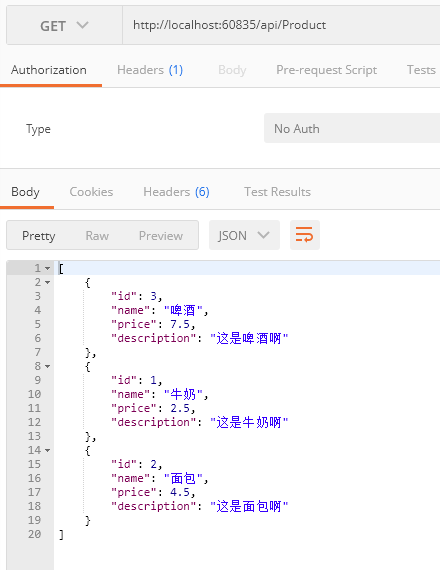
结果正确。
然后修改GetProduct:
[Route("{id}", Name = "GetProduct")]public IActionResult GetProduct(int id, bool includeMaterial = false) //默认没有对应的材料{var product = _productRepository.GetProduct(id, includeMaterial); //替换之前的ProductServiceif (product == null){return NotFound();}if (includeMaterial){//赋值到对应的productDtovar productWithMaterialResult = new ProductDto{Id = product.Id,Name = product.Name,Price = product.Price,Description = product.Description};foreach (var material in product.Materials){productWithMaterialResult.Materials.Add(new MaterialDto{Id = material.Id,Name = material.Name});}return Ok(productWithMaterialResult);}var onlyProductResult = new ProductDto{Id = product.Id,Name = product.Name,Price = product.Price,Description = product.Description};return Ok(onlyProductResult);}
首先再添加一个参数includeMaterial表示是否带着Material表的数据一起查询出来,该参数有一个默认值是false,就是请求的时候如果不带这个参数,那么这个参数的值就是false。
通过repository查询之后把Product和Material分别映射成ProductDto和MaterialDot。
试试,首先不包含Material: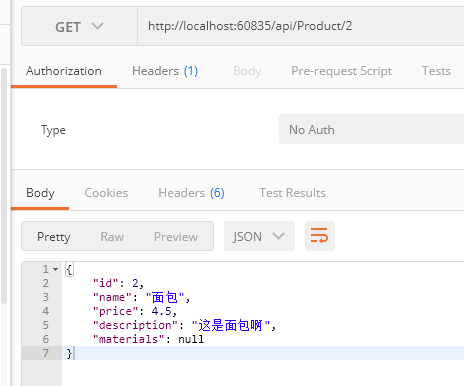
目前数据库的Material表没有数据,可以手动添加几个,也可以把数据库的Product数据删了,改一下种子数据那部分代码:
namespace CoreBackend.Api.Entities{public static class MyContextExtensions{public static void EnsureSeedDataForContext(this MyContext context){if (context.Products.Any()){return;}var products = new List<Product>{new Product{Name = "牛奶",Price = new decimal(2.5),Description = "这是牛奶啊",Materials = new List<Material> //add material{new Material{Name = "水"},new Material{Name = "奶粉"}}},new Product{Name = "面包",Price = new decimal(4.5),Description = "这是面包啊",Materials = new List<Material>{new Material{Name = "面粉"},new Material{Name = "糖"}}},new Product{Name = "啤酒",Price = new decimal(7.5),Description = "这是啤酒啊",Materials = new List<Material>{new Material{Name = "麦芽"},new Material{Name = "地下水"}}}};context.Products.AddRange(products);context.SaveChanges();}}}
然后再试试GetProduct带有material的查询:(?includeMaterial=true)
其中**inludeMaterail这个参数需要使用query string**的方式,也就是在uri后边加一个问号,问号后边跟着参数名,然后是等号,然后是它的值。如果有多个query string的参数,那么每组参数之间用&分开。
然后再修改一下MaterialController:
namespace CoreBackend.Api.Controllers{[Route("api/product")] // 和主Model的Controller前缀一样public class MaterialController : Controller{private readonly IProductRepository _productRepository;public MaterialController(IProductRepository productRepository){_productRepository = productRepository;}[HttpGet("{productId}/materials")]public IActionResult GetMaterials(int productId){var materials = _productRepository.GetMaterialsForProduct(productId);var results = materials.Select(material => new MaterialDto{Id = material.Id,Name = material.Name}).ToList();return Ok(results);}[HttpGet("{productId}/materials/{id}")]public IActionResult GetMaterial(int productId, int id){var material = _productRepository.GetMaterialForProduct(productId, id);if (material == null){return NotFound(); //2 product存在,而它没有下属的}var result = new MaterialDto{Id = material.Id,Name = material.Name};return Ok(result);}}}
注意GetMaterials方法内,我们往productRepository的GetMaterialsForProduct传进去一个productId,如果repository返回的是空list可能会有两种情况:1 product不存在,2 product存在,而它没有下属的material。如果是第一种情况,那么应该返回的是404 NotFound,而第二种action应该返回一个空list。所以我们需要一个方法判断product是否存在,所以打开ProductRepository,添加方法:
并在pull up member(右键点击方法代码—重构里面有)到接口里面:
namespace CoreBackend.Api.Repositories{public interface IProductRepository{IEnumerable<Product> GetProducts();Product GetProduct(int productId, bool includeMaterials);IEnumerable<Material> GetMaterialsForProduct(int productId);Material GetMaterialForProduct(int productId, int materialId);bool ProductExist(int productId);}}
然后再改一下Controller:
namespace CoreBackend.Api.Controllers{[Route("api/product")] //和主Model的Controller前缀一样public class MaterialController : Controller{private readonly IProductRepository _productRepository;public MaterialController(IProductRepository productRepository){_productRepository = productRepository;}[HttpGet("{productId}/materials")]public IActionResult GetMaterials(int productId){var product = _productRepository.ProductExist(productId);if (!product){return NotFound();}var materials = _productRepository.GetMaterialsForProduct(productId);var results = materials.Select(material => new MaterialDto{Id = material.Id,Name = material.Name}).ToList();return Ok(results);}[HttpGet("{productId}/materials/{id}")]public IActionResult GetMaterial(int productId, int id){var product = _productRepository.ProductExist(productId);if (!product){return NotFound();}var material = _productRepository.GetMaterialForProduct(productId, id);if (material == null){return NotFound();}var result = new MaterialDto{Id = material.Id,Name = material.Name};return Ok(result);}}}
试试: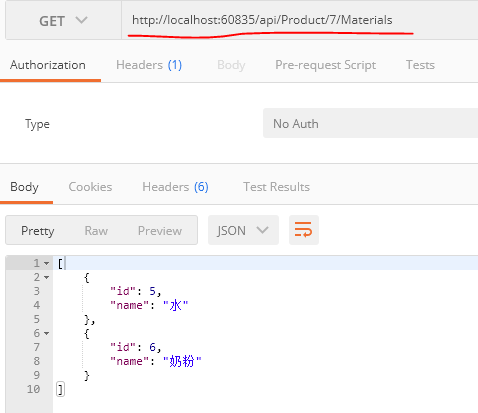



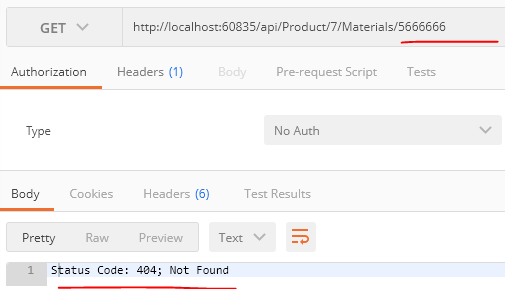
结果都没有问题!!!
但是看看上面controller里面的代码,到处都是映射,这种手写的映射很容易出错,如果entity有几十个属性,然后在多个地方需要进行映射,那么这么写实在太糟糕了。
所以需要使用一个映射的库:
AutoMapper
autoMapper是最主流的.net映射库,所以我们用它。
通过nuget安装automapper: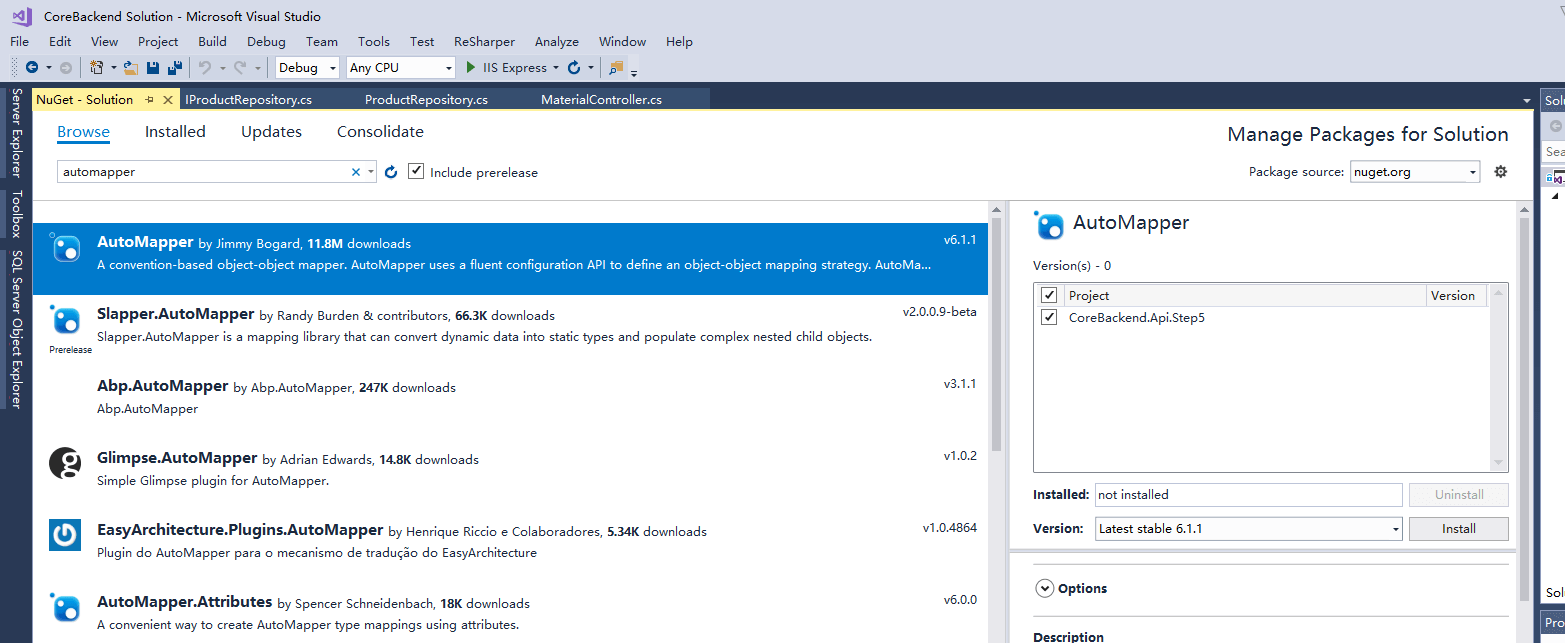
安装完之后,首先要配置automapper。我们要告诉automapper哪些entity和dto之间有映射关系。这个配置应该只创建一次,并且在startup的时候进行初始化。
在Startup的Configure方法添加:
public void Configure(IApplicationBuilder app, IHostingEnvironment env, ILoggerFactory loggerFactory,MyContext myContext){loggerFactory.AddNLog();if (env.IsDevelopment()){app.UseDeveloperExceptionPage();}else{app.UseExceptionHandler();}myContext.EnsureSeedDataForContext();app.UseStatusCodePages();//添加autoMapAutoMapper.Mapper.Initialize(cfg =>{cfg.CreateMap<Product, ProductWithoutMaterialDto>();});app.UseMvc();}
创建映射关系,我们需要使用AutoMapper.Mapper.Initialize方法,其参数是一个Action,这个Action的参数是一个Mapping Configuration。
cfg.CreateMap
AutoMapper是基于约定的,原对象的属性值会被映射到目标对象相同属性名的属性上。如果属性不存在,那么就忽略它。
偶尔我们可能需要对AutoMapper的映射进行一些微调,但是对于大多数情况来说,上面这一句话就够用了。
现在可以在controller里面使用这个映射了。
打开controller首先改一下GetProducts:
[HttpGet]public IActionResult GetProducts(){var products = _productRepository.GetProducts();var results = Mapper.Map<IEnumerable<ProductWithoutMaterialDto>>(products);return Ok(results);}
使用Mapper.Map进行映射,
运行试试: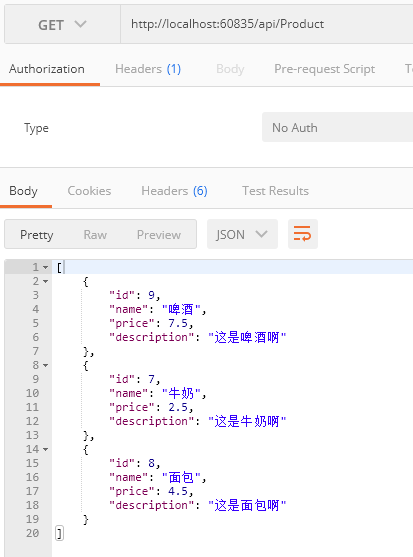
没问题,结果和之前是一样的。
然后针对GetProduct,首先再建立一对映射:
AutoMapper.Mapper.Initialize(cfg =>{cfg.CreateMap<Product, ProductWithoutMaterialDto>();cfg.CreateMap<Product, ProductDto>();});
然后GetProduct:
[Route("{id}", Name = "GetProduct")]public IActionResult GetProduct(int id, bool includeMaterial = false){var product = _productRepository.GetProduct(id, includeMaterial);if (product == null){return NotFound();}if (includeMaterial){var productWithMaterialResult = Mapper.Map<ProductDto>(product);return Ok(productWithMaterialResult);}var onlyProductResult = Mapper.Map<ProductWithoutMaterialDto>(product);return Ok(onlyProductResult);}
运行,查询包含Material,报错:
这是因为ProductDto里面有一个属性 ICollection
AutoMapper.Mapper.Initialize(cfg =>{cfg.CreateMap<Product, ProductWithoutMaterialDto>();cfg.CreateMap<Product, ProductDto>();cfg.CreateMap<Material, MaterialDto>();});
运行: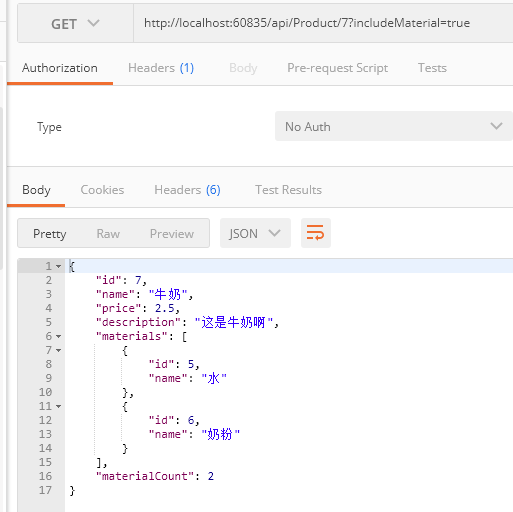
没问题。
然后把MaterailController里面也改一下:
AutoMapper.Mapper.Initialize(cfg =>{cfg.CreateMap<Product, ProductWithoutMaterialDto>();cfg.CreateMap<Product, ProductDto>();});
运行一下都应该没有什么问题。
上面都是查询的Actions。
下面开始做CUD的映射更改。
添加:
修改ProductRepository,添加以下方法:
public void AddProduct(Product product){_myContext.Products.Add(product);}public bool Save(){return _myContext.SaveChanges() >= 0;}
AddProduct会把传进来的product添加到context的内存中(姑且这么说),但是还没有更新到数据库。
Save方法里面是把context所追踪的实体变化(CUD)更新到数据库。
然后把这两个方法提取到IProductRepository接口里:
public interface IProductRepository{IEnumerable<Product> GetProducts();Product GetProduct(int productId, bool includeMaterials);IEnumerable<Material> GetMaterialsForProduct(int productId);Material GetMaterialForProduct(int productId, int materialId);bool ProductExist(int productId);void AddProduct(Product product);bool Save();}
修改Controller的Post:
[HttpPost]public IActionResult Post([FromBody] ProductCreation product){if (product == null){return BadRequest();}if (product.Name == "产品"){ModelState.AddModelError("Name", "产品的名称不可以是'产品'二字");}if (!ModelState.IsValid){return BadRequest(ModelState);}var newProduct = Mapper.Map<Product>(product);_productRepository.AddProduct(newProduct);if (!_productRepository.Save()){return StatusCode(500, "保存产品的时候出错");}var dto = Mapper.Map<ProductWithoutMaterialDto>(newProduct);return CreatedAtRoute("GetProduct", new { id = dto.Id }, dto);}
Put
cfg.CreateMap<ProductModification, Product>();
[HttpPut("{id}")]public IActionResult Put(int id, [FromBody] ProductModification productModificationDto){if (productModificationDto == null){return BadRequest();}if (productModificationDto.Name == "产品"){ModelState.AddModelError("Name", "产品的名称不可以是'产品'二字");}if (!ModelState.IsValid){return BadRequest(ModelState);}var product = _productRepository.GetProduct(id);if (product == null){return NotFound();}Mapper.Map(productModificationDto, product);if (!_productRepository.Save()){return StatusCode(500, "保存产品的时候出错");}return NoContent();}
这里我们使用了Mapper.Map的另一个overload的方法,它有两个参数。这个方法会把第一个对象相应的值赋给第二个对象上。这时候product的state就变成了modified了。
然后保存即可。
试试: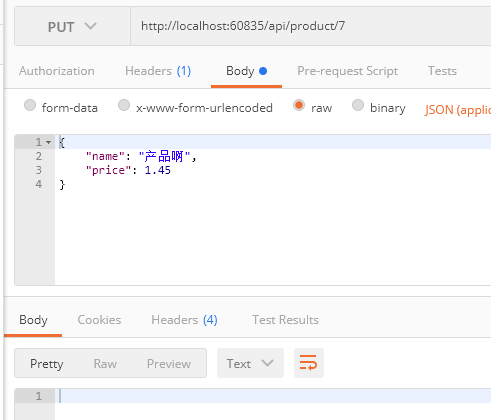
Partial Update
cfg.CreateMap
[HttpPatch("{id}")]public IActionResult Patch(int id, [FromBody] JsonPatchDocument<ProductModification> patchDoc){if (patchDoc == null){return BadRequest();}var productEntity = _productRepository.GetProduct(id);if (productEntity == null){return NotFound();}var toPatch = Mapper.Map<ProductModification>(productEntity);patchDoc.ApplyTo(toPatch, ModelState);if (!ModelState.IsValid){return BadRequest(ModelState);}if (toPatch.Name == "产品"){ModelState.AddModelError("Name", "产品的名称不可以是'产品'二字");}TryValidateModel(toPatch);if (!ModelState.IsValid){return BadRequest(ModelState);}Mapper.Map(toPatch, productEntity);if (!_productRepository.Save()){return StatusCode(500, "更新的时候出错");}return NoContent();}
Delete
只是替换成repository,不涉及mapping。
在Repository添加一个Delete方法:
public void DeleteProduct(Product product){_myContext.Products.Remove(product);}提取到IProductRepository:void DeleteProduct(Product product);
然后Controller:
[HttpDelete("{id}")]public IActionResult Delete(int id){var model = _productRepository.GetProduct(id);if (model == null){return NotFound();}_productRepository.DeleteProduct(model);if (!_productRepository.Save()){return StatusCode(500, "删除的时候出错");}_mailService.Send("Product Deleted",$"Id为{id}的产品被删除了");return NoContent();}
运行:
Ok。
第一大部分先写到这。。。。。。。。。。。。
接下来几天比较忙,然后我再编写第二大部分。我会直接弄一个已经重构好的模板,简单讲一下,然后重点是Identity Server 4.
到目前为止可以进行CRUD操作了,接下来需要把项目重构一下,然后再简单用一下Identity Server4。

